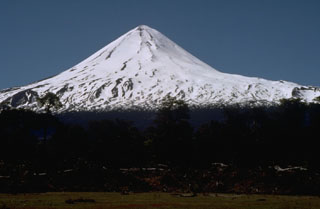Report on Llaima (Chile) — August 1992
Bulletin of the Global Volcanism Network, vol. 17, no. 8 (August 1992)
Managing Editor: Lindsay McClelland.
Llaima (Chile) Three summit-crater explosions; frequent seismicity
Please cite this report as:
Global Volcanism Program, 1992. Report on Llaima (Chile) (McClelland, L., ed.). Bulletin of the Global Volcanism Network, 17:8. Smithsonian Institution. https://doi.org/10.5479/si.GVP.BGVN199208-357110
Llaima
Chile
38.692°S, 71.729°W; summit elev. 3125 m
All times are local (unless otherwise noted)
Three explosions from the summit crater were observed between 23 August and 2 September. Intense fumarolic and solfataric activity has continued since 23 August, with gas emissions and phreatic explosions in early September that rose 400 m and fed a plume 45 km long. About 2500 seismic events were recorded 4-6 September by two portable MEQ-800 seismographs 5 km from the crater; tremor frequency was 1.2-1.4 Hz. Seismicity was concentrated on the N flank where the 1956-57 eruptions occurred. Seismicity during fieldwork in January 1991 and January 1992 averaged a few hundred events per day (17:2). Winter snow still covers the volcano, creating the potential for lahars.
Geological Summary. Llaima, one of Chile's largest and most active volcanoes, contains two main historically active craters, one at the summit and the other, Pichillaima, to the SE. The massive, dominantly basaltic-to-andesitic, stratovolcano has a volume of 400 km3. A Holocene edifice built primarily of accumulated lava flows was constructed over an 8-km-wide caldera that formed about 13,200 years ago, following the eruption of the 24 km3 Curacautín Ignimbrite. More than 40 scoria cones dot the volcano's flanks. Following the end of an explosive stage about 7200 years ago, construction of the present edifice began, characterized by Strombolian, Hawaiian, and infrequent subplinian eruptions. Frequent moderate explosive eruptions with occasional lava flows have been recorded since the 17th century.
Information Contacts: G. Fuentealba, M. Petit-Breuilh, and P. Peña,Univ de la Frontera; U.S. Embassy, Santiago, Chile.

